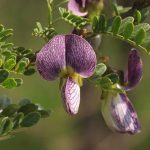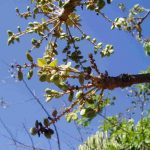TREE LIFE
December 1986
MASHONALAND CALENDAR
Saturday December 6th : Mukuvisi Woodland Key. The last workshop on Meg’s key to the trees and shrubs in the Woodlands was most encouraging. Those present enjoyed themselves and contributed greatly to the development of the key, which has since undergone revision. I have worked on many keys and was most impressed at how well Meg’s ideas work in the field. We would therefore welcome everyone for another session of keying. Come along for the morning, meet at 0900 hours or the afternoon, meet at 1400 hours, or bring along some lunch and stay for both. If you don’t know your trees then we would value your help. Venue : Meg’s house at 12 Kariba Crescent, Hillside, phone 84419.
Sunday December 14th : Social at Meg’s, see directions above. Meet at 12 Kariba Crescent at 0945 for tea/coffee, provided. At 1-30 hours we will split into teams and go over to the Mukuvisi Woodlands where Meg has organized a Botanical Scavenger Hunt Competition, some of you may remember a previous one at Arbor Acres. At 1230 hours return to 12 Kariba Crescent to mark the results of the competition followed by lunch, bring your own, tea and coffee provided. Afternoon – relax or go over to the Woodlands. There will be a Security Guard to look after cars and we will ask for contributions to cover that cost.
Friday January 30th – Sunday February 1st : We hope to spend a day at Quiet Waters Conservation project, Falcon College, Esigodini. This is an exciting project which has included the tagging of about 9oo trees of the more common species and a few of the more rare ones. It will be most rewarding to join up with the Bulawayo Branch and visit the project. At present the arrangements are own transport, own accommodation, who is interested? Please contact Meg Coats Palgrave at 84419 Harare.
MATABELELAND BRANCH
Sunday December 7th : Circular Drive at the Old Gwanda Road end. Meet at 0830 in the Circular Drive, just off the Old Gwanda Road.
On Sunday November 2nd we had a good turn out and went to the Matopos, mainly the Whitewaters area. In all we identified some 80 tree species. On the way in we saw Acacia mellifera heavily in seed, and Acacia tortilis which occurs along the Antelope Road, it is probably distributed by cattle as they move from one Outspan to another. In among the kopjes we saw Acokanthera rotundata, Afzelia quanzensis, Albizia antunesiana,
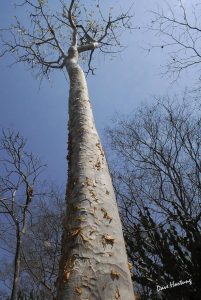
Albizia tanganyicensis. Photo: Dave Hartung. Source: Flora of Zimbabwe.
Albizia tanganyicensis, Albizia versicolor, Aloe excelsa, Artabotrys brachypetalus, Brachylaena rotundata, Calodendrum capense flowering well, Carissa bispinosa, the Y thorn, Cassine matabelica, Catha edulis, Commiphora marlothii, Commiphora pyracanthoides, Cordia grandicalyx, Crossopteryx febrifuga even with some under bark crystals, Diospyros mespiliformis, Euclea racemosa subsp. schimperi and what we thought was Euclea crispa, Ficus ingens in very red new leaf, Heteropyxis dehniae full of lavender scent, Lonchocarpus capassa, the Rain Tree, but quite dry, Maytenus heterophylla subsp. puberula, the Matopos subspecies with its relatively tiny leaves, Mimusops zeyheri, Mundulea sericea, flowering, Ochna glauca in beautiful new red leaf, instead of the usual blue green,
Ochna pulchra peeling notably, Pavetta eylesii, Rhus lancea, Rhus leptodictya, Rhus pyroides was very common, Strychnos matopensis both climbing and as a scrambling shrub, Tarchocanthus camphoratus, Tarenna zimbabwensis, formerly Enterospermum rhodesiacum, Tetradenia brevispicata, formerly Iboza riparia, a Vernonia which uncertain as its leaves were very young and small, Ximinea caffra, Zanthoxylum capensis, formerly Fagara.
Altogether we had a very good day, thanks to our usual guides.
-C.Sykes,
BOTANIC GARDEN WALK – 4TH NOVEMBER 1986 : FLOWERING TREES, THEIR POLLINATION AND CULTIVATION
No matter what else we plan to do in November, the garden is always such a blaze of colour it seems a pity not to enjoy it all once again. In addition Tom has agreed to discuss cultivation of each tree as we go so that these hints can be compiled together.
Flowers attract pollinators to encourage cross fertilization between different trees of the same species. This simple statement belies the complexity of the whole process. If cross pollination is advantageous then the pollinator needs to travel between trees and this is simplified if neighbouring trees are in sight of each other and the pollinator has a good eyesight. We may think that this does not occur in dense forests like the Vumba but then we see these forests from a human perspective. We saw
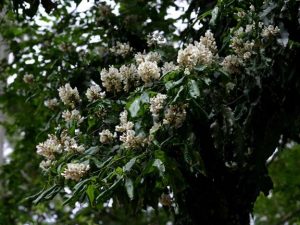
Craibia brevicaudata. Photo: Bart Wursten. Source: Flora of Zimbabwe
Craibia brevicaudata in flower in the gardens, this specimen had been attacked by whitefly and so its flowering was delayed. Standing below the flowers look small but looking over at the forest from a vantage point the white trees stand out boldly against the deep green forest, so there is a line of sight for a high flying insect. These pea like flowers are often pollinated by insects that are strong enough, or heavy enough, to depress the keel petals and thus expose the anthers. Generalizations like this are dangerous, as was learned in last years A-level paper which asked teachers to put out a large legume flower. Many teachers put out the exotic Erythrina crista-galli, it was quite a shock when the question papers were eventually unsealed and students were asked to give five reasons why the flower was suited to insect pollination. Unfortunately E.crista-galli has a very reduced wing petal, is a deep red-black colour and has a strong keel that can only be depressed by birds. The seeds of Crabia germinate easily in the moist forest conditions and Tom’s trees were collected as small seedlings. Transplanting small, less than 20cm tall, seedlings is a most successful propagation technique for trees that grow in wet areas like rain forests or in dense riverine or stream bank vegetation, e.g. Celtis africana. The ground is usually soft and so little damage is done to the roots. In addition the root system is usually equally small. This technique seldom works with savanna trees as these often develop an extensive rooting system with very little growth above ground. Palm seedlings often do not transplant well as they have complex germination patterns. Raphia grows a long root with hardly any growth above ground and Barassus develops a long “umbilical” cord between its embryo and its seed and so transplanting is more difficult than it seems. In contrast juvenile palms may transplant well. Two other forest trees which we saw in showy white flower were
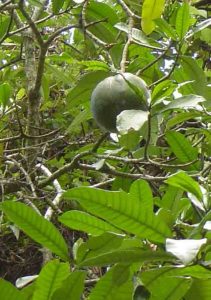
Tabernaemontana stapfiana. Photo: Bart Wursten. Source: Flora of Zimbabwe
Tabernaemontana stapfiana and T.ventricossa, both belong to the APOCYNACEAE and have white flowers that resemble a frangipani, but are more delicate. In thick forest a visual attractant may not be enough as the line of sight is limited, and so scent becomes important, and both these species are heavily scented. The stimulus of smell is no good unless it can direct the pollinator. Scent generally travels in the direction of the wind and results in the development of a scent trail that starts with the tree and fans out downstream depending on the direction and strength of the wind. Potential pollinators that detect the scent usually fly into the wind, tacking back and forth when the scent trail becoming faint, which indicates that they have reached the edge of the fan. Eventually they see the flowers and the visual stimulus takes over from the scent and they home in. T.stapfiean, T.angolensis, from the Vumba Forest grows to a height of 10 – 15m where it develops fruit the size and weight of a medicine ball. When these balls have ripened in the canopy they come careering down with an alarming thud which may be heard with remarkable frequency. We almost lost Molly in the Vumba when one landed a meter or so from her. Once on the ground they rot so disposal seems to be very limited. The seeds of most forest trees need to be planted fresh and with T.stapfiana one is never sure when the seed is ripe and fresh or rotten, so only trial and error works. In Harare these trees are plagued by a caterpillar that rolls the leaves up and may defoliate the tree as well. T.ventricosa is an under storey shrub and Tom’s specimen is larger than they usually occur in the forests. They grow well in deep shade and so Tom has used them at the entrance to the Conference Centre.
Passing the Ficus bubu we found two members of the RUBIACEAE, both under storey plants in low altitude rain forest and both in full flower. Cremaspora triflora is the number one shrub of some forests and is covered in heavily scented white flowers. Aidia micrantha shows a strong resemblance to a coffee bush. Making our way to the Anthocleista lawn we passed Feretia aeruginescens in full flower. It also belongs to the RUBIACEAE and grows in the hot Zambezi Valley. It can be a most attractive shrub or scrambling bush with red foliage and big red fruit. The flowers are white with a bit of pink. They grow easily from seed.
We passed the Albizia gummifera which is almost over but has red and white shaving brushes and produces much nectar for the bees that pollinate it. Last year our tree at The Shambles was visited by a swarm of rose beetles. Beetle pollinated flowers usually produce a mass of pollen and thick fleshy petals as beetles are great eaters – they devour the petals on pollinate in passing. Our Albizia did not stand a chance, the swarm descended just before sunset and ate their way through the tree, and so the tree which usually sets much seed was fruitless this year except for a solitary branch that possible flowered out of time with the rest of the tree.
The Anthocleista grandiflora were in flower but the grand flora are so high they are difficult to see. Those on the ground showed the strange flower with a whole lot (11- 13) of hard petals. This tree withstands drought well, and grows quickly, yet its leaves are enormous and hard.
We passed a Schotia brachypetala in red flower and wandered on the Cladostemon kirkii. I have written on this spectacular flower more than once so will not repeat it all again. It has a smell that some may consider to be rotten but Tom relates to wine sauce on beef stroganoff. These trees have never fruited but apparently they grow well from fresh seed. Cuttings are an alternate method of growth but in order to be really successful they need shade house conditions with bottom heating. They have the advantages of being identical to the parent plant and so one will know how well they should flower.
The Albizia versicolor was in flower as well. Unlike Acacia, the seeds of Albizias do not need to be scarred or heated or dropped in acid. They grow easily when the seed is soaked in water overnight and planted fresh. Both the Rhigosum brevispinosum and R.zambesiacum were in full flower, these are real 3 day wonders and are solid yellow bushes. Most amazing garden subjects. These bushes grow in dry open bushveld and so are easily spotted from a great distance. The Strophanthus kombe was heavy with its long petals. The seeds germinate easily but then suffer with damping off. Just behind the Strophanthus we found Xylia torreana with its balls of cream to white flowers. This was a new sight for many of us. While in the S.E. lowveld section we also looked at the flowers on the Sabi Star, Wrightia natalensis, Grewia hexamita and Monodora junodii. Tom says all the Grewia species grow easily, as does the Monodora, although Tom’s specimen has often flowered, but never fruited. The Acacia karroo was in yellow pompoms. This species has a very wide geographical range and may be slightly different in different parts of its range. Acacia seeds are sometimes difficult to germinate. In every batch of seeds there are some that just require soaking and they will germinate. But as a protection against erratic rainfall most of the seeds are covered with an impermeable coat or testa. This testa stops water from getting to the seed and so germination is prevented, and germination is delayed until the testa rots away. To grow these seeds the testa must be damaged and this can be done by grinding away the corner of the seed, very carefully, on a grindstone until the white seed is seen, only a fraction of a millimeter needs to be removed, or dropping them in a cup of boiling water and allowing the water to cool, this risks cooking the seed altogether, or dropping them carefully into sulphuric acid – a dangerous occupation but one which Tom finds works well. Cheryl uses the grinding trick and has much success although Tom says they often germinate a bit skew.The sun was getting low when we began a cross garden sprint to see Tom’s violet tree, Securidaca longepedunculata in full flower. Tom grew these from seed collected near Bulawayo as the short shoots on which the flowers grow are much shorter down there and so the bunches of flowers are tighter and thus more spectacular. This tree is a difficult one to grow beyond a certain stage, they don’t like their roots disturbed and may die when planted out. Once established they grow well. On the way back we saw Gardenia spathulifolia which Tom says grow well and very easily from seed. The professor recently collected fruit from Lake Kyle and brought them back to me and commented on the fact that he saw nothing eating them despite the fact that they smelt so sweet. A week later Rosemary Browne arrived back from Lake MacIlwaine after a birdie weekend to say the monkeys were going wild in the Gardenia bushes, tearing open the fruit. Does anyone have any other observations?
Thanks once again, Tom, an entertaining evening.
-KIM DAMSTRA.
The following is an outline of a talk I presented to a workshop held at the Ambassador Hotel in October and funded by Rural Afforestation. It was most successfully chaired by Mr. Colin Phiri, Rural Afforestation, and co-organized by Mrs. Vangile Titi, Association of Women’s Clubs. I am indebted to Tom Muller for valuable discussions before the conference. This excellent workshop showed that many grass roots organizations are keen to get going and have asked for help and advice as to what to grow and how to grow it. I believe Tree Society members have this help and so propose that we compile a booklet as a guide to growing indigenous trees. To do this we need your ideas on this outline, what do you agree with or disagree with, how can it be altered? We need data on what you have grown, how easy it was, and what soils you prefer. What containers are cheap and effective? Would you recommend boiling, the acid treatment or scarification? What fruit trees would you like to see cultivated? Recipes for what to do with the fruit once you have it? How to cook indigenous products, for example, can anyone cook okra so that it tastes less snotty? Records on firewood and how fast it grows? Everyone is always too busy to write it all down, so why not write it in short notes and I will compile them. This is an opportunity for you to help the community and our woodlands.
GROWING INDIGENOUS TREES
Growing trees takes time and sustained enthusiasm so it is vitally important that we know why we wish to embark on a tree growing project. This is even more important when we are dealing with indigenous trees. So why grow trees?
1) FOR WOOD : Indigenous trees are often the preferred firewood but many of our indigenous trees have been over utilized and in order to reduce pressure on the woodlands the growing of gums has been recommended. If grown properly these woodlots may be very successful. Remember we are growing gums in order to save our indigenous woodlands, therefore we can assess our success in growing gums by the state of the surrounding woodlands, not the state of the gums.
2) FOR FRUIT : There are a number of well known indigenous fruits; mutchwe, Azanza garckeana, mutumba, Srychnos innocua, mutsubvu, Vitex payos and muchinga, Friesodielsia obovata. But if fruit is the most important consideration in planting a tree, then plant a productive tree like an Avocado, a mango, an orange or a paw ppaw tree. In the long run they will produce more.
3) FOR SHADE OR AS AN ORNAMENTAL TREE : Yes indeed, we have some excellent shade trees that double up as fruit trees as well; Mukute, Syzygium cordatum and Syzygium quineense, Muchechete, Mimusops zeyheri which grows next to the conical tower at Great Zimbabwe and may even have been planted for this very reason, Mukuyu, Ficus sycomorus is a tree that has been planted as a shade tree for many hundreds of years, most school children know the story of Zacchaeus who climbed the one that was planted as a roadside shade tree in Jericho, sycamorus are indigenous to Zimbabwe and not in Jericho.
4) FOR EDUCATION : This is one of the most important reasons for planting indigenous trees. These trees are very much part of the rich cultural tradition that is in danger of being lost if not passed on. I find it distressing when I need to teach A-level students muchaha, Paranari curatellifolia, mukarati, Burkea africana and mopane, Colophospermum mopane, simply because they have not been taught to value the knowledge their parents have. Education leads to active conservation, and planting indigenous trees is one of the most positive steps we can take towards this education. For this reason, it is important to select a spot close to a school or a cultural centre.
HOW TO GROW INDIGENOUS TREES
1) BY PROTECTION : Many of our indigenous trees will re-grow from root stock if given a chance. They simply need protection from fire and grazing. Fire is often controlled by slashing the grass but if not carefully done, slashing may destroy the tree seedlings as well, particularly when a tractor is used. In these cases, only those trees that grow four to six feet in one season that may be noticed by the driver and thus escape being mown down. There is much evidence of this in and around Harare.
2) BY TRANSPLANTING SELF SOWN TREES : Seedlings often germinate well but then die out in the dry season. These small seedlings may be dug out carefully, planted in packets and watered throughout the dry season in preparation for the National Tree Planting Day. We have had great success with planting out mugara, Celtis africana this way. Small seedlings, less than 10cm tall, transplant better and then grow faster. For this exercise it is often better to select trees which grow naturally along rivers and in wet areas because often small trees in open woodland have such an extensive root stock they die in transplanting.
3) BY CUTTINGS OR TRUNCHEONS : As a general rule, this works well with trees that have a soft wood or a milky sap. In this case, a branch, one to three meters is cut down and planted, preferably in sandy soil, and watered well. The smaller twigs can be pruned off as all the leaves will die off anyway. It may be months before these sticks show any signs of life so watering must continue. Growing branches like this is already practiced in the rural areas, for example with chizhonje, mukumbukumbu, Lannea discolor. Other suitable trees are mukwa, Pterocarpus angolensis, mukuyu, Ficus sycomorus and F.sur., and Mubvuka and related trees, the Commiphora genus.
4) GROWING BY SEED: We find this most successful. Seedlings seem to adapt faster than cuttings. There are two kinds of seeds :
Those that have a dormant period. These seeds are protected by a hard coat around the seed and the seed cannot start growing until this coat is removed. The thorn trees fall into this group, muunga, muguunga, Acacia species. The seed coat of these seeds need to be ground down a bit without damaging the seed inside. The edge of the seed can be ground carefully on a grinding stone, only grind off less than a millimeter, and then soak the seed in cold water overnight. Some people drop the seed into a small amount of hot water in oder to start growth. The thorn trees grow well if cared for, although they may spend the first few years growing strong roots.
Those that have no dormant period : Most of our seed have no dormant period. These seeds can be collected fresh, soaked in water overnight and planted.
GROWING SEEDLINGS : Plastic packets are expensive but we find milk packets are strong and very suitable. They come in two sizes, 500ml and 1 l. A drainage hole must be cut in the bottom corner. Beer cartons have also been used successfully. We fill the packets with a mixture of compost, river sand and soil. The sand is important for good drainage as seedlings rot if waterlogged. 3 seeds are planted in each packet. Plant seeds just a bit deeper than the height of the seed and go on watering regularly for months as seeds often take a long while to come up. Seedlings must not dry out completely and with good drainage this means that in hot weather they may need to be watered every day. During cold weather once every two days to one a week may e enough. Seedlings will die if not watered properly.
THE LEATT’S FARM, CONCESSION, NOVEMBER 1986
From Harare we traveled out on the green stone belt, cutting through the Iron Mask Range at Mazowe Dam and heading north to Concession where there is a small intrusion of granite on the west of the road, and this forms the impressive outcrop of boulders which is on the Leatt’s Farm. We were pleased to welcome the enthusiasts from Centenary.
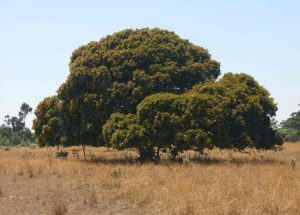
Parinari curatellifolia, Photo: Bart Wursten. Source: Flora of Zimbabwe.
Paranari curatellifolia, that shaded an area large enough for us all to enjoy our picnic lunch, but that was later. Beneath was an indaba tree which has the Sindebele name uzagogwne, Pappea capensis. This small tree still had serrated leaf margins, but these are lost as the tree matures. Along the base of the hiss we found mutsibvu, Vitex payos, with its delicate purple and white verbena like flowers, and a large leaved Canthium lactescens that displayed, for all to see, it lactating apical buds. Here amongst the rocks were the large pink and yellow flowers of Kaempferia rosea, a member of the ginger family ZINGIBERACEAE. I was surprised to learn that the petals are fairly inconspicuous and this large pink ‘petal’ is really three sterile stamens fused together.
During the day we found three Commiphora species, mutedza, Commiphora marlothii and muchemwa, which refers to Commiphora mollis and Commiphora mossambicensis. The roots of all three of these species are apparently quite palatable raw, I would have thought them to be resinous. The mutedza was a magnificent specimen supporting one of the mutsamvi, figs, as an epiphyte. This one was Ficus ingens, with its spear shaped leaves. As we approached the saddle we came across a large muchenya, Zanha africana, covered in green fruit. These ripen to a translucent orange and are edible. At this time of the year there has been a rapid growth of all the buds and so one cannot find the typical “ball and claw” bud that we use in the dry season to confirm the identification of this species.We were fortunate enough to find flowers on both sexes of mutunguru, Flacourtia indica. The flowers on the male trees are a pom pom of yellow anthers whereas the female flowers were tinged with red and the lobed ovary was crowned with a number of styles. High above us were Muunze, Brachystegia glaucescens, with their fine foliage and smooth bark. Making our way up the steep hillside I collected a shrubby tree growing between two rocks and was one which rang no bells in the brain. Brian Best returned with it to Bob who identified it as Erythrocacca trichogyne of the EUPHORBIACEAE. The pale green alternate leaves are soft, thin and furry with an irregular margin. I am sorry now we did not look at it for longer. A low leafless bush had us puzzled until we found one in full leaf, kapurupuru, Ormocarpum kirkii, especially with its worm like fruit inside the dried petals. Having seen the dark bark on mutamba, Strychnos spinosa, earlier on, we were able to compare it with the powdery bark on the mukwakwa, Strychnos innocua. This Shona name applies equally to Srychnos madagascariensis, which is similar but lacks the powdery bark. And a typical mufufu, Securidaca longepedunculata, fooled some of us until we saw the remains of an old fruit and a number of young flower buds. George demonstrated how well the bark strips to produce a fiber, apparently it is suitable for making rope, string, cloth and even fishing nets. According to Watt and Breyer-Brandwijk, (1962) the fiber is of excellent quality but contains much gum. The energetic folk climbed to the top of the boulders but others were way laid my musaswa, Bequaertiodendron magalismontanum, in green fruit, chiwirowiro, Hymenodictyon floribundum, and a highly scented mupfupa, Tarenna neurophylla, covered in small white flowers. Wandering down the hillside Meg pointed out an orange butterfly, Phylanta phylanta, a most interesting species whose larvae feed on members of the FLACOURTACEAE and the SALICACEAE. Why is this significant? For years botanists arranged the willows and poplars, SALICACEAE, along with all other families that lacked petals, this arrangement is followed in Coates Palgrave. Recently this relationship has seemed strange and the SALICACEAE were seen to be out of place – the question was where do they belong? Well, the answer is, you guessed it – alongside the FLACOURTACEAE. I must add that Professor Cottrell who knows the butterflies well and has a vast knowledge of the indigenous flora, always warns me that this reverse botanizing may be exciting but it can also be very misleading. I thank the butterfly folk for this interesting snippet.
After lunch we wandered along the sandy track towards the Leatt’s house and headed for the rocks once again. The November heat I find exhausting and the rains have still now broken so we moved sluggishly from patch of shade to patch of shade. A deeply shaded cleft in the rock was cool, and also contained Apodites dimidiata, Maytenus undata and Rothmannia fischeri. After some persuasion we agreed that the BIGNONIACEAE we were seeing was a pink jacaranda, Stereospermum kunthianum. The afternoon ended with the discovery of a mural of rock art and then a rapid migration back for tea and cold drinks.
The journey home was enriched by the sight of many muunga, Acacia, thorn trees I flower. These included the splendid display of cream spikes on Acacia polyacantha, the yellow balls on Acacia karroo, and the cream balls on Acacia sieberiana. We must thank the Leatts who, in their absence, provided such a suitable venue.
-KIM DAMSTRA.
KIM DAMSTRA CHAIRMAN


